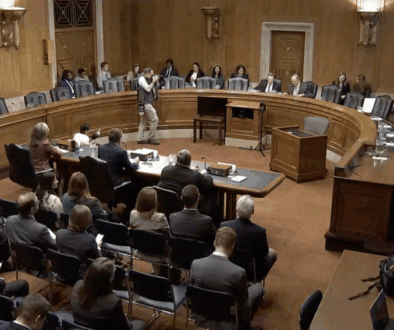Listen to the audio version of this article (generated by AI).
Nearly 20% of packaged foods and drinks in the US have synthetic dyes, with most marketed to children and loaded with sugar, according to a new study that examined nearly 40,000 items from popular food brands.
The study, published in the Journal of the Academy of Nutrition and Dietetics, comes amid a federal push to rid the US food supply of synthetic dyes and follows recent commitments by food giants Kraft Heinz and General Mills to remove such dyes from their products. It also adds to evidence — often cited by those opposing synthetic dyes in foods — that the chemicals disproportionately end up in sugary foods aimed at kids. Research has linked the chemicals to children’s behavioral issues, including increased risk for Attention Deficit/Hyperactivity Disorder (ADHD).
Lead author Elizabeth Dunford, a professor and researcher at both the University of North Carolina and the University of New South Wales, said she approached the research as a curious mom.
“I have two young kids and definitely notice behavior changes after certain foods. I got really interested in the synthetic dyes in particular and thought ‘well let’s take a look,’” Dunford said.
Cakes, cookies and candy
It is hard to pin down how many packaged foods are sold in the US, but it is estimated at more than 230,000 items. Dunford and colleagues used a large database of food labels and ingredients to examine 39,763 items made by the top 25 food manufacturers (including Kraft Heinz and General Mills) from US grocery stores. They found 19% of items contained synthetic dyes. These items represent about $46 billion of US food spending.
“I have two young kids and definitely notice behavior changes after certain foods.” -Elizabeth Dunford, University of North Carolina and the University of New South Wales
The data was from 2020, which was the most recent available, Dunford said. “I doubt suddenly it has drastically gone down,” she said, adding that she plans to redo the analysis in a few years when new data is available.
The top food categories most likely marketed to children — candy, sugary drinks, ready meals, breakfast cereals and cakes, cookies, and pastries — were also most likely to contain synthetic dyes, with 28% containing the chemicals compared to just 11% of other items in other categories. Items made with synthetic dyes had, on average, 141% more sugar than non-dyed items.

The findings align with claims from Department of Health and Human Services (HHS) Secretary Robert F. Kennedy Jr. that food makers are targeting children with foods full of dyes and sugar.
HHS and the Food and Drug Administration (FDA) announced in April that they wanted a “voluntary” commitment from food makers to rid the US food system of synthetic dyes.
“These poisonous compounds offer no nutritional benefit and pose real, measurable dangers to our children’s health and development,” Kennedy said in a statement in April, and added that “sugar is poison” during the accompanying press conference.
The agencies approved three new natural food dyes in May, expanding the natural food dye options for companies. The availability of natural dyes, along with cost increases, disruptions to supply chains, recipes and manufacturing processes, remains a concern among some experts as HHS and others push for a swift phaseout.
Christopher Gindlesperger, a spokesperson for the National Confectioners Association, a trade association representing companies that make a variety of sweets, said the analysis in the new study has “major gaps.”
“This report measures the amount of dyes in the food system but ignores exposure to consumers,” Gindlesperger said. “Consumers have a unique mindset when they enjoy chocolate and candy that is not present when interacting with other foods. They know that confectionery products are treats and that they contain sugar, food colors, and other FDA-approved ingredients.”
Gindlesperger also pointed out that the companies in the report that have candy and chocolate as their main products have committed to not advertising to children under 12.
Thomas Galligan, co-author of the new study and principal scientist for food additives and supplements at the Center for Science in the Public Interest, said the study’s results show “a range in companies’ proportional use of dyes in many food categories suggest that reduction in use is readily feasible.”
Food companies making changes
The new study comes as some top food makers are moving to slash their use of synthetic dyes.
Kraft Heinz, the maker of dozens of popular brands such as Oscar Mayer, Jell-O, Velveeta and Kool-Aid, announced last week that it will not launch any new foods with synthetic dyes and will remove the dyes from its current products by the end of 2027.
“These poisonous compounds offer no nutritional benefit and pose real, measurable dangers to our children’s health and development.” -Robert F. Kennedy Jr., HHS
General Mills, which makes popular brands that include Betty Crocker, Nature Valley and Annie’s Homegrown, has also announced it will remove synthetic dyes from all its food by 2027, with a shorter timeline for cereals and other foods used in schools.
PepsiCo told investors in April that brands like Lays and Tostitos would be made without artificial colors by the end of this year, and that the company expects to offer consumers natural color options for its entire portfolio of products within the next couple of years.
The new study found that 15% of Kraft Heinz items, 19% of General Mills items and 31% of PepsiCo items contained synthetic dyes. Ferrero, behind candy brands like Jelly Belly, SweetTarts, Laffy Taffy and Nerds, had the highest percentage of items that contained synthetic dyes at 60%.
This is not the first time companies have made commitments about synthetic dyes, Dunford pointed out. “If you go back 10 years, a lot of companies claimed they were going to remove them and most did not, so the claims don’t mean anything without action and so what I’m hoping is that this study provides a baseline.
“Let’s see if they actually followed through with the commitments because I think that’s what’s lacking,” she said. “You can say anything you want, but will you really do it?”
Featured image: Onur Burak Akın at Unplash +




June 29, 2025 @ 9:42 am
Interesting that there was not one mention in this article that RFK, Jr. is part of the Trump Administration, and that President Trump placed RFK, Jr. in his position as the head of the HHS to, among other things, clean up our food supply and address all the other factors that has led to Americans being some of the most unhealthy people on the planet. You NEVER mention the MAHA (Make America Healthy Again) movement started by the Trump Administration.
You never fail to call attention to anything negative being attributed to the Trump Administration, something you never did with the Biden Administration. You never mentioned that problems you had with the EPA, etc. (under the Biden Administration) were part of the Biden Administration. It was always “Trump’s EPA”, it was never “Biden’s EPA.”
I have to believe that if President Trump cured cancer, you would find a way to report it without mentioning his name in a positive manner. Just saying…
June 30, 2025 @ 8:16 am
Bob — thanks so much for writing in.
We have covered RFK Jr. and the MAHA movement quite extensively. We don’t always point out that Trump appointed Kennedy because, frankly, that’s kind of assumed. We don’t do that with other appointees either. I can assure you that we aren’t seeking negative coverage for the Trump administration and we remain nonpartisan. The Trump administration has taken aim at — or already scrapped — many of the regulations that reduce pollution, and we do cover that. While some see that as negative, others may not.
Here are just a few examples of MAHA coverage lately. There are much more in the archives. Thanks again for reading.
Health advocates applaud MAHA report for calling out chemical harms, but say it falls short
FDA approves three natural food dyes amid push to eliminate synthetics
FDA moves to phase out petroleum-based food dyes
It’s not just RFK Jr — Opposition to fluoride in drinking water grows
FDA must fix food packaging rules for MAHA to matter, scientists say